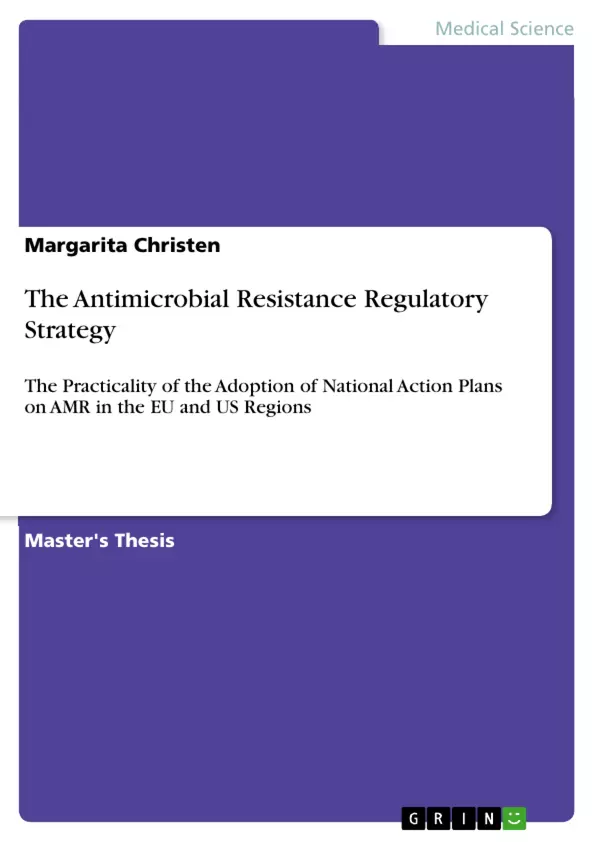Some years after the first use of penicillin, resistant bacteria emerged. The phenomenon of resistance has continued to show up similarly for almost every marketed antibiotic product, endangering the safety of humans, animals and the environment.
This major threat has been proven to have a worldwide impact. In response, national action plans must be implemented following "anti-resistance" guidance: WHO’s Global Action Plan on Antimicrobial Resistance (GAP-AMR) in collaboration with FAO and OIE. These plans are to be adopted by 2017, aiding the protection of antibiotic medicines adhering to the approach of One Health.
The aim of the current study was to review the process of such adoptions in the EU and US, understand its practicality, challenges and any out of scope issues.With the use of a phenomenological approach, this qualitative study found that thanks to the general population’s increment in knowledge and awareness, collaboration and engagement grew stronger, especially among policy makers and pharmaceutical companies, but also healthcare leaders and providers, physicians and veterinarians, and patients.
When trying to discover new antibiotic drugs, serendipity is not an option, therefore, companies must be incentivised to increase their antibiotic pipelines. During the analysis of the inclusion of the plans, a paradox appeared: due to the reduced use of antibiotics, it is difficult to motivate drug developers to increase research in new medicines and alternative forms of treatment. The research concluded, that legislation must be focused on supporting changes that will ease entry of antibiotics to the market (i.e. with a congruent regulatory pathway and/or with financial support of governments) to allow a practical inclusion of the national plans.
Inhaltsverzeichnis (Table of Contents)
- Abstract
- Table of Contents
- Table of Figures
- Table of Tables
- Chapter 1. INTRODUCTION
- 1.1. Introduction
- 1.2. Background of the Research
- 1.3. Justification of the Research
- 1.4. Aims, Objectives and Scope of the Research
- 1.4.1. The Three Pillars
- 1.4.2. Strategy and Timelines
- 1.4.3. Summary
- 1.5. Outline of the Dissertation
- 1.6. Summary
- Chapter 2. LITERATURE REVIEW
- 2.1. Introduction
- 2.2. Antimicrobial History
- 2.2.1. Microbes and Diseases
- 2.2.2. Facing Resistance
- 2.2.3. Global Action Plan Overview
- 1.2. The European Union AMR Strategy
- 1.2.1. Regulatory Institutions and Organizations
- 1.2.2. The Antimicrobial Regulation in the EU
- 1.2.3. The EU Enforcement Against AMR
- 1.2.4. Summary
- 1.3. The United States AMR Approach
- 1.3.1. The US Legal Structure
- 1.3.2. The U.S. National Plan Outline
- 1.3.3. The US Enforcement Against AMR
- 1.3.4. Summary
- 1.4. Comparison of Strategy
- 1.4.1. National Policy
- 1.4.2. Antibiotic Stewardship
- 1.4.3. Incentives, Budgeting and Costing
- 1.4.4. Outside Aspects
- 1.4.5. Summary
- 1.5. Conclusions
- Chapter 2. METHODOLOGY
- 2.1. Introduction
- 2.2. Research Design
- 2.2.1. Choice of Research Methods
- 2.3. Population and Sampling
- 2.4. Data Collection
- 2.4.1. Questionnaires
- 2.4.2. Semi-structured Interviews
- 2.5. Data Analysis
- 2.6. Validity, Reliability and Bias
- 2.7. Ethics
- 2.8. Limitations
- 2.9. Summary
- 2.10. Conclusions
- Chapter 3. PRESENTATION AND ANALYSIS OF DATA
- 3.1. Introduction
- 3.2. Questionnaire Results
- 3.2.1. Awareness and Communication
- 3.2.2. Antibiotic Usage
- 3.2.3. Changes in Legislation
- 3.2.4. Summary
- 3.3. Interview Results
- 3.3.1. Regulatory Approaches
- 3.3.2. National Plan Implications
- 3.3.3. Challenges and Practicality
- 3.3.4. Out of Scope Aspects
- 3.3.5. Summary
- 3.4. Respondent's Recommendations
- 3.5. Conclusions
- Chapter 5. DISCUSSION
- 5.1. Introduction
- 5.2. Discussion
- 5.2.1. Findings in Relation to the Research Objectives
- 5.2.1.1. The EU and US Approaches on AMR (RO1)
- 5.2.1.2. Plan Implementation Impacts (RO2)
- 5.2.1.3. Challenges and Practicality (RO3)
- 5.2.1.4. Out of scope Aspects (RO4)
- 5.2.1.5. Summary of Findings
- 5.3. Key Conclusions
- 5.4. Limitations and Recommendations for Future Research
- 5.5. Research Reflexions
- 5.6. Final Conclusions
- Antimicrobial Resistance and Its Global Impact
- National Action Plans for AMR in the EU and US
- Challenges and Practicalities of Implementing National Action Plans
- Stakeholder Engagement and Collaboration
- Incentivizing Research and Development of New Antibiotics
- Chapter 1: Introduction
- Chapter 2: Literature Review
- Chapter 2: Methodology
- Chapter 3: Presentation and Analysis of Data
Zielsetzung und Themenschwerpunkte (Objectives and Key Themes)
This dissertation investigates the practicality of implementing national action plans on antimicrobial resistance (AMR) in the EU and US regions. It analyzes the adoption process, identifies challenges, and explores out-of-scope issues. The research utilizes a phenomenological approach to understand the perspectives of stakeholders, including policy makers, pharmaceutical companies, healthcare providers, and patients.
Zusammenfassung der Kapitel (Chapter Summaries)
This chapter provides an overview of the research topic, outlining the background of AMR, the rationale for the study, and the research objectives. It also presents the dissertation's structure.
This chapter explores the history of antimicrobials, including the emergence of resistance, and the development of global action plans to address the issue. It examines the AMR strategies of the EU and US, focusing on their regulatory frameworks, enforcement mechanisms, and policy approaches.
This chapter outlines the research methodology, including the research design, data collection methods, and data analysis techniques. It discusses the population and sampling strategies, ethical considerations, and limitations of the study.
This chapter presents and analyzes the data collected from questionnaires and interviews, highlighting the findings on stakeholder awareness, antibiotic usage, legislative changes, and the implications of national action plans. It includes perspectives on regulatory approaches, challenges, and out-of-scope aspects.
Schlüsselwörter (Keywords)
The dissertation focuses on antimicrobial resistance, national action plans, regulatory strategy, One Health approach, stakeholder engagement, antibiotic stewardship, research and development, and the EU and US regions.
- Citar trabajo
- Margarita Christen (Autor), 2017, The Antimicrobial Resistance Regulatory Strategy, Múnich, GRIN Verlag, https://www.grin.com/document/385477



